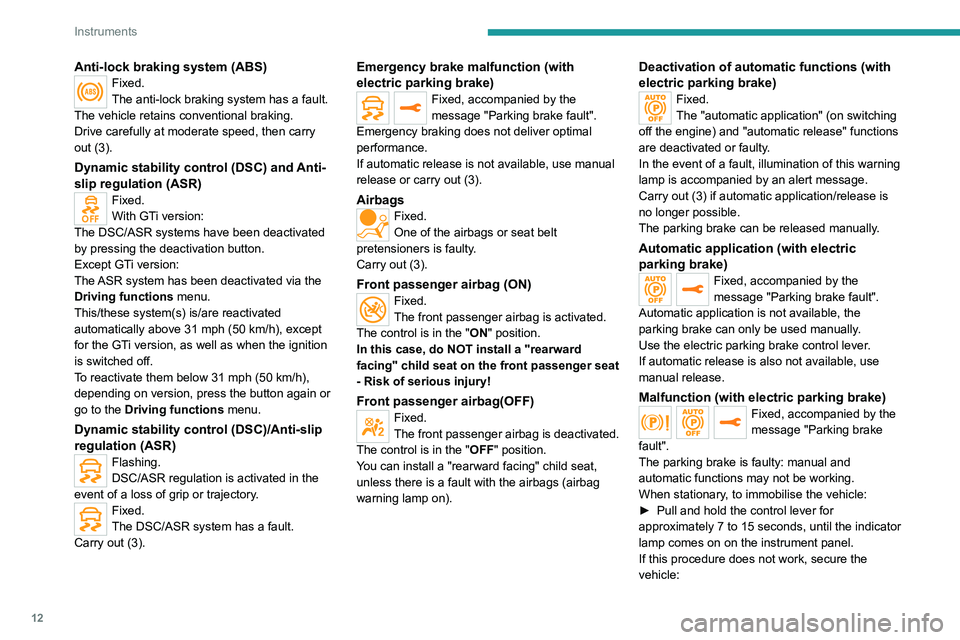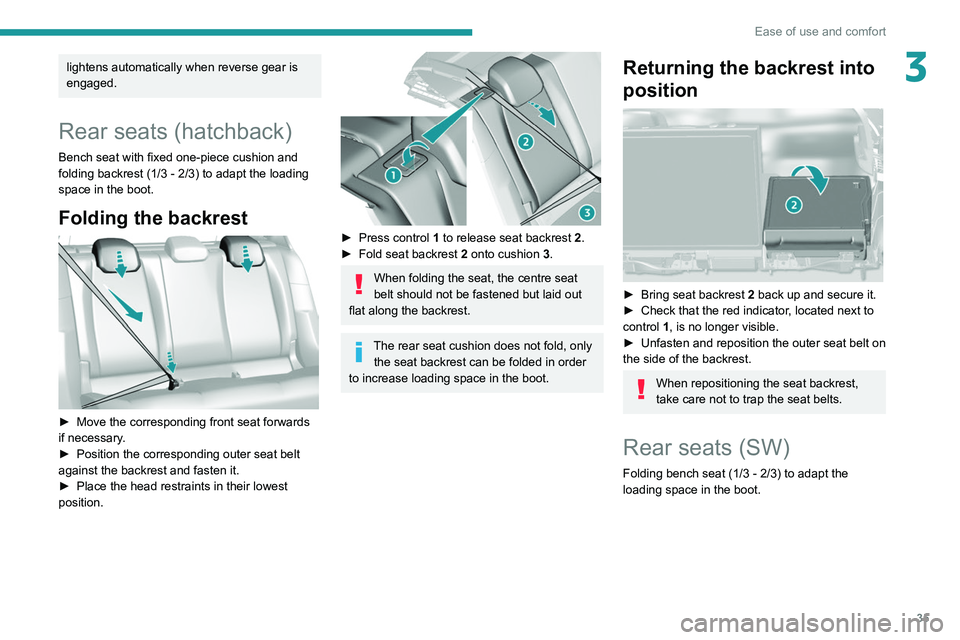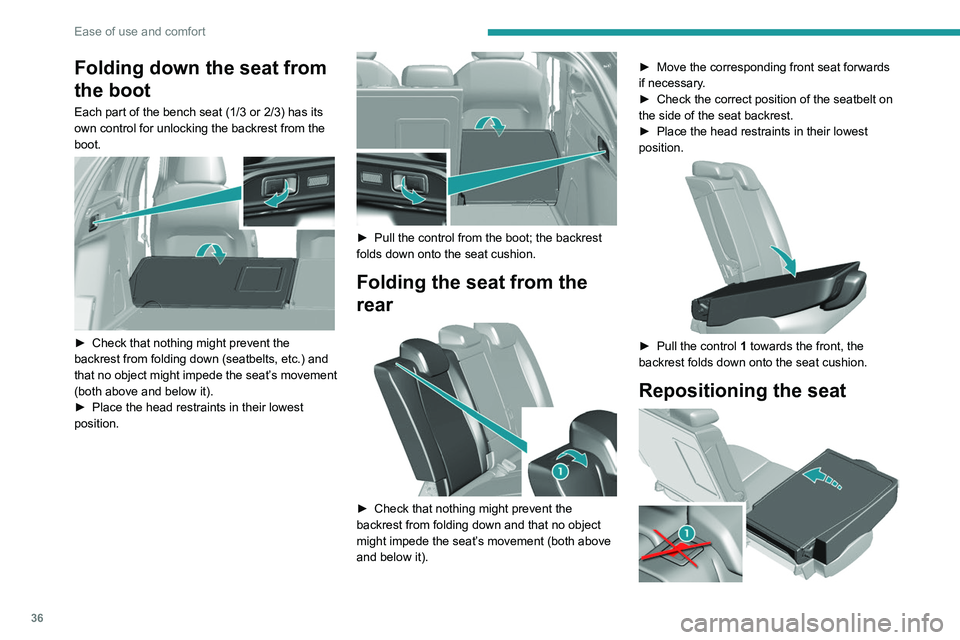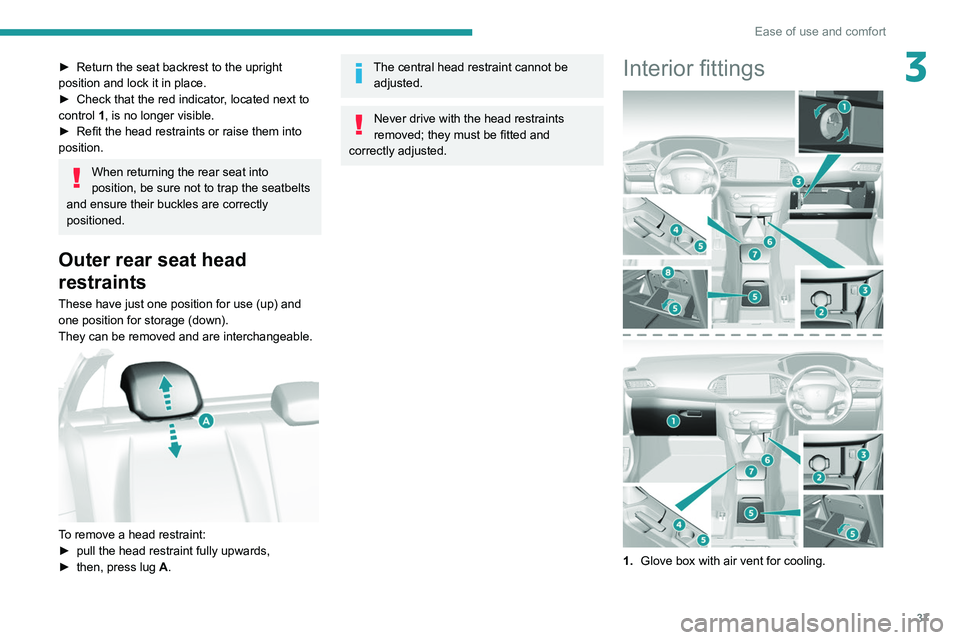2021 Peugeot 308 belt
[x] Cancel search: beltPage 4 of 244

2
Contents
■
Overview
Labels 4
■
Eco-driving
1Instruments
Digital instrument panel 7
Warning and indicator lamps 8
Indicators 14
Manual test 17
Total distance recorder 17
Lighting dimmer 17
Trip computer 18
2Access
Electronic key with remote control function
and built-in key, 19 Keyless Entry and Starting 21
Back-up procedures 23
Doors 25
Boot 25
Alarm 26
Electric windows 28
3Ease of use and comfort
PEUGEOT i-Cockpit 30
Front seats 30
Steering wheel adjustment
33
Mirrors 33
Rear seats (saloon) 35
Rear seats (SW) 35
Interior fittings 37
Front armrest 38
Boot fittings (hatchback) 40
Boot fittings (SW) 40
Warning triangle (stowing) 41
Heating and Ventilation 42
Manual air conditioning 43
Dual-zone automatic air conditioning 44
Front demisting - defrosting 46
Rear screen demisting/defrosting 47
Panoramic sunroof 47
Courtesy lamps 48
Interior ambient lighting 49
4Lighting and visibility
Exterior lighting control stalk 50
Automatic illumination of headlamps 51
Automatic headlamp dipping 52
Guide-me-home and welcome lighting 53
Direction indicators 53
Headlamp beam height adjustment 54
Wiper control stalk 54
Changing a wiper blade 56
Automatic wipers 56
5Safety
General safety recommendations 58
Hazard warning lamps 58
Emergency or assistance call
59
Horn 61
Electronic stability control (ESC) 62
Seat belts 64
Airbags 66
Child seats 68
Deactivating the front passenger airbag 70
ISOFIX child seats 74
Child lock 79
6Driving
Driving recommendations 81
Starting/switching off the engine 82
Manual parking brake 85
Electric parking brake 86
Hill start assist 89
5-speed manual gearbox 89
6-speed manual gearbox 90
Automatic gearbox EAT6 90
Automatic gearbox EAT8 93
Driver Sport Pack 96
Gear efficiency indicator 97
Stop & Start 97
Under-inflation detection 99
Driving and manoeuvring aids - General
recommendations
100
Speed Limit Recognition and
Recommendation
102
Speed limiter 104
Cruise control 106
Adaptive Cruise Control 107
Active Safety Brake with Distance Alert and
Intelligent emergency braking assistance
11 2
Distraction detection
11 4
Active Lane Keeping Assistance 11 5
Blind Spot Monitoring 11 9
Page 7 of 244

5
Overview
1.Bonnet release
2. Dashboard fuses
3. Courtesy lamp
Warning lamps display for seat belts and front
passenger airbag
Interior ambience lighting
Interior rear view mirror
Emergency and assistance call buttons
4. Touch screen with PEUGEOT Connect Radio
or PEUGEOT Connect Nav
5. Air conditioning controls
6. Stop & Start button
Gearbox controls
Driver Sport Pack
7. Manual parking brake
Electric parking brake
8. USB socket
9. Horn
10. Digital instrument panelSteering-mounted controls
1.Exterior lighting control stalks/Direction
indicators
2. Wipers/Screenwash/Trip computer control
stalk
3. Audio volume controls/Choice of instrument
panel display mode
4. Controls for Cruise control/Speed limiter/
Adaptive Cruise Control
Side control bar
1.Deactivation/Reactivation of DSC and ASR
(GTi version) 2.
Deactivation/Reactivation of Stop & Start
3. Deactivation/Reactivation of Active Lane
Departure Warning System
4. Deactivation of the interior volumetric and
anti-tilt monitoring alarm
5. Headlamp beam height adjustment wheel
Central control bar
1.Hazard warning lamps switch
2. Locking/unlocking from inside control
Page 11 of 244

9
Instruments
1If a warning lamp remains lit
The references (1), (2) and (3) in the warning
and indicator lamp description indicate whether
you should contact a qualified professional in
addition to the immediate recommended actions.
(1): You must stop the vehicle.
Stop as soon as it is safe to do so and switch off
the ignition.
(2): Contact a PEUGEOT dealer or a qualified
workshop.
(3): Visit a PEUGEOT dealer or a qualified
workshop.
List of warning and
indicator lamps
Red warning/indicator lamps
STOP
Fixed, associated with another warning
lamp, accompanied by the display of a
message and an audible signal.
A serious fault with the engine, braking system,
power steering, automatic gearbox or a major
electrical fault has been detected.
Carry out (1) and then (2).
Engine oil pressureFixed.
There is a fault with the engine lubrication
system.
Carry out (1) and then (2).
BrakingFixed.
The brake fluid level in the braking circuit
has dropped significantly.
Carry out (1), then top up with fluid that complies
with the manufacturer's recommendations. If the
problem persists, carry out (2).
Fixed.
The electronic brake force
distribution
(EBFD) system is faulty.
Carry out (1) and then (2).
Parking brakeFixed.
The parking brake is applied or not
properly released.
Electric parking brakeFlashing.
The electric parking brake is not applied
automatically.
The application/release is faulty.
Carry out (1) on level ground (horizontally).
–
with a manual gearbox, with a gear engaged.
–
with an automatic gearbox, with the lever in
position P
.
Then carry out (2).
12V battery charge (depending on country
of sale)
Fixed.
The battery charging circuit has a fault
(dirty terminals, slack or cut alternator belt, etc.).
Carry out (1). If the electric parking brake stops working,
immobilise the vehicle:
►
With the manual gearbox, engage a gear
.
►
With the EA
T6 automatic gearbox, move the
gear selector to position
P
.
►
With the EA
T8 automatic gearbox, fit the
chock against one of the wheels.
Clean and tighten the terminals. If the warning
lamp does not go off when the engine is started,
carry out (2).
Door(s) openFixed, associated with a message
identifying the door.
If one of the doors or the boot is not fully closed
(speed below 6 mph [10 km/h]).
Fixed, associated with a message
identifying the door, together with an
audible signal.
If one of the doors or the boot is not fully closed
(speed above 6 mph [10 km/h]).
Seat belts not fastened/unfastenedFixed or flashing, accompanied by an
audible signal.
A seat belt has not been fastened or has been
unfastened.
Low fuel levelFixed, with the reserve level shown in red,
accompanied by an audible signal and
the display of a message.
When it first comes on, you have approximately
6 litres of fuel remaining in the tank (reserve).
Page 13 of 244

11
Instruments
1Under-inflation warning lamp
flashing then fixed and Service
warning lamp fixed.
The tyre pressure monitoring system is faulty.
Under-inflation detection is no longer monitored.
Check the tyre pressures as soon as possible
and carry out (3).
AdBlue® (BlueHDi)On for around 30 seconds when starting
the vehicle, accompanied by a message
indicating the driving range.
The driving range is between 1,500 and 500
miles (2,400 and 800
km).
Top up the AdBlue
®.Fixed, on switching on the ignition,
accompanied by an audible signal and a
message indicating the driving range.
The driving range is between 500 and 62 miles
(800 and 100
km).
Promptly top up the AdBlue
®, or carry out (3).Flashing, accompanied by an audible
signal and a message indicating the
driving range.
The driving range is less than 62 miles (100
km).
You must top up the AdBlue
® to avoid engine
starting being prevented , or carry out
(3).
Flashing, accompanied by an audible
signal and a message indicating that
starting is prevented.
The AdBlue
® tank is empty: the legally required
engine immobiliser system prevents the engine
from starting. To restart the engine, top up the AdBlue
® or carry
out (2).
It is essential to add at least 5 litres of AdBlue
®
to the tank.
SCR emissions control system (BlueHDi)Fixed when the ignition is switched
on, accompanied by an audible
signal and a message.
A malfunction of the SCR emissions control
system has been detected.
This alert disappears once the exhaust
emissions return to normal levels.
Flashing AdBlue® warning lamp on
switching on the ignition, with the
Engine self-diagnostics warning lamp on fixed,
accompanied by an audible signal and a
message indicating the driving range.
Depending on the message displayed, it is
possible to drive for up to 685 miles (1,100
km)
before the engine immobiliser is triggered.
Carry out (3) without delay, to avoid starting
being prevented.
Flashing AdBlue® warning lamp on
switching on the ignition, with the
Engine self-diagnostics warning lamp on fixed,
accompanied by an audible signal and a
message indicating that starting is prevented.
The engine immobiliser prevents the engine from
restarting (the permitted driving limit has been
exceeded after confirmation of a malfunction of
the emissions control system).
To start the engine, carry out (2).
Distance Alert/Active Safety BrakeFixed, accompanied by the display of a
message.
The system has been deactivated via the vehicle
configuration menu.
Flashing.
The system activates and brakes the
vehicle momentarily to reduce the speed of
collision with the vehicle in front.
Fixed, accompanied by a message and
an audible signal.
The system has a fault.
Carry out (3).
Fixed.
The sensors in the driver's
seat (and/or front passenger seat, depending
on version) have detected a weight but the
corresponding seat belt has not been fastened.
Diesel engine preheatingTemporarily on. When switching on the ignition, if the
weather conditions and the engine temperature
make it necessary.
Wait until the warning lamp goes off before
starting.
With
Keyless Entry and Starting, when the
warning lamp goes off, starting is immediate if
you press and hold:
–
the clutch pedal with a manual gearbox.
–
the brake pedal with an automatic gearbox.
If the engine does not start, switch the ignition off
and then on, wait until the lamp goes off again,
then start the engine.
Page 14 of 244

12
Instruments
Anti-lock braking system (ABS)Fixed.
The anti-lock braking system has a fault.
The vehicle retains conventional braking.
Drive carefully at moderate speed, then carry
out (3).
Dynamic stability control (DSC) and Anti-
slip regulation (ASR)
Fixed.
With GTi version:
The DSC/ASR systems have been deactivated
by pressing the deactivation button.
Except GTi version:
The ASR system has been deactivated via the
Driving functions menu.
This/these system(s) is/are reactivated
automatically above 31 mph (50 km/h), except
for the GTi version, as well as when the ignition
is switched off.
To reactivate them below 31 mph (50 km/h),
depending on version, press the button again or
go to the Driving functions menu.
Dynamic stability control (DSC)/Anti-slip
regulation (ASR)
Flashing.
DSC/ASR regulation is activated in the
event of a loss of grip or trajectory.
Fixed.
The DSC/ASR system has a fault.
Carry out (3).
Emergency brake malfunction (with
electric parking brake)
Fixed, accompanied by the
message "Parking brake fault".
Emergency braking does not deliver optimal
performance.
If automatic release is not available, use manual
release or carry out (3).
AirbagsFixed.
One of the airbags or seat belt
pretensioners is faulty.
Carry out (3).
Front passenger airbag (ON)Fixed.
The front passenger airbag is activated.
The control is in the "ON" position.
In this case, do NOT install a "rearward
facing" child seat on the front passenger seat
- Risk of serious injury!
Front passenger airbag(OFF)Fixed.
The front passenger airbag is deactivated.
The control is in the "OFF" position.
You can install a "rearward facing" child seat,
unless there is a fault with the airbags (airbag
warning lamp on).
Deactivation of automatic functions (with
electric parking brake)
Fixed.
The "automatic application" (on switching
off the engine) and "automatic release" functions
are deactivated or faulty.
In the event of a fault, illumination of this warning
lamp is accompanied by an alert message.
Carry out (3) if automatic application/release is
no longer possible.
The parking brake can be released manually.
Automatic application (with electric
parking brake)
Fixed, accompanied by the
message "Parking brake fault".
Automatic application is not available, the
parking brake can only be used manually.
Use the electric parking brake control lever.
If automatic release is also not available, use
manual release.
Malfunction (with electric parking brake)Fixed, accompanied by the
message "Parking brake
fault".
The parking brake is faulty: manual and
automatic functions may not be working.
When stationary, to immobilise the vehicle:
►
Pull and hold the control lever for
approximately 7 to 15 seconds, until the indicator
lamp comes on on the instrument panel.
If this procedure does not work, secure the
vehicle:
Page 37 of 244

35
Ease of use and comfort
3lightens automatically when reverse gear is
engaged.
Rear seats (hatchback)
Bench seat with fixed one-piece cushion and
folding backrest (1/3 - 2/3) to adapt the loading
space in the boot.
Folding the backrest
► Move the corresponding front seat forwards
if necessary .
►
Position the corresponding outer seat belt
against the backrest and fasten it.
►
Place the head restraints in their lowest
position.
► Press control 1 to release seat backrest 2.
► Fold seat backrest 2 onto cushion 3.
When folding the seat, the centre seat
belt should not be fastened but laid out
flat along the backrest.
The rear seat cushion does not fold, only the seat backrest can be folded in order
to increase loading space in the boot.
Returning the backrest into
position
► Bring seat backrest 2 back up and secure it.
► Check that the red indicator , located next to
control 1, is no longer visible.
►
Unfasten and reposition the outer seat belt on
the side of the backrest.
When repositioning the seat backrest,
take care not to trap the seat belts.
Rear seats (SW)
Folding bench seat (1/3 - 2/3) to adapt the
loading space in the boot.
Page 38 of 244

36
Ease of use and comfort
Folding down the seat from
the boot
Each part of the bench seat (1/3 or 2/3) has its
own control for unlocking the backrest from the
boot.
► Check that nothing might prevent the
backrest from folding down (seatbelts, etc.) and
that
no object might impede the seat’s movement
(both above and below it).
►
Place the head restraints in their lowest
position.
► Pull the control from the boot; the backrest
folds down onto the seat cushion.
Folding the seat from the
rear
► Check that nothing might prevent the
backrest from folding down and that no object
might
impede the seat’s movement (both above
and below it). ►
Move the corresponding front seat forwards
if necessary
.
►
Check the correct position of the seatbelt on
the side of the seat backrest.
►
Place the head restraints in their lowest
position.
► Pull the control 1 towards the front, the
backrest folds down onto the seat cushion.
Repositioning the seat
Page 39 of 244

37
Ease of use and comfort
3► Return the seat backrest to the upright
position and lock it in place.
►
Check that the red indicator
, located next to
control 1, is no longer visible.
►
Refit the head restraints or raise them into
position.
When returning the rear seat into
position, be sure not to trap the seatbelts
and ensure their buckles are correctly
positioned.
Outer rear seat head
restraints
These have just one position for use (up) and
one position for storage (down).
They can be removed and are interchangeable.
To remove a head restraint:
► pull the head restraint fully upwards,
►
then, press lug
A.
The central head restraint cannot be adjusted.
Never drive with the head restraints
removed; they must be fitted and
correctly adjusted.
Interior fittings
1. Glove box with air vent for cooling.